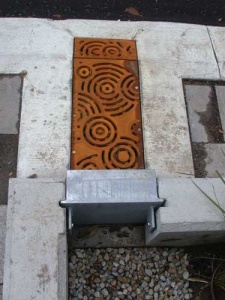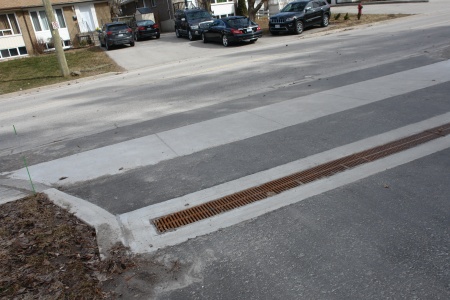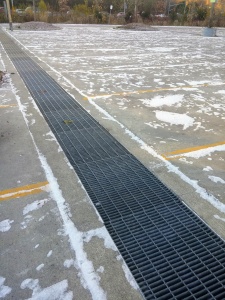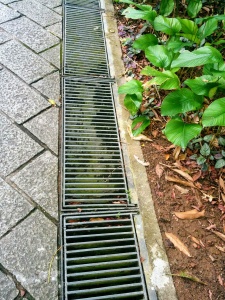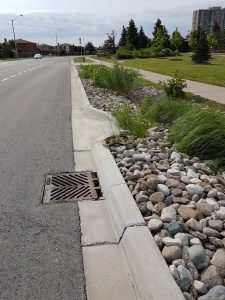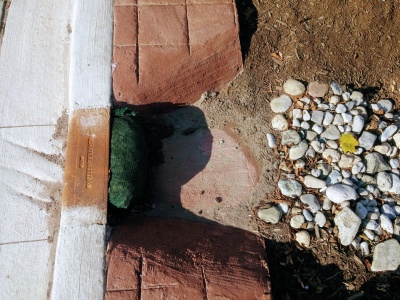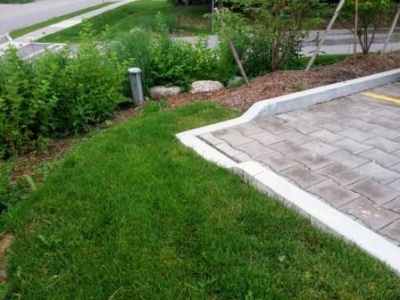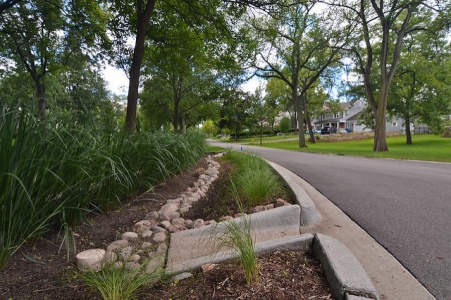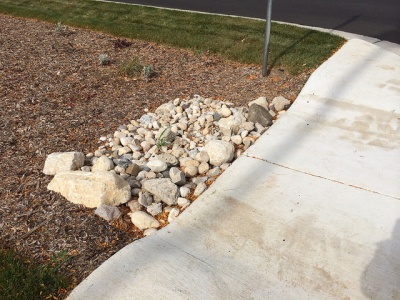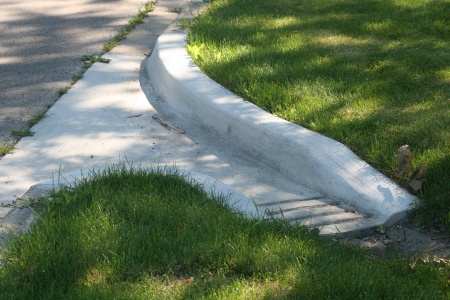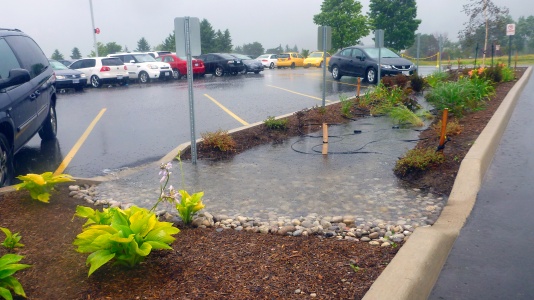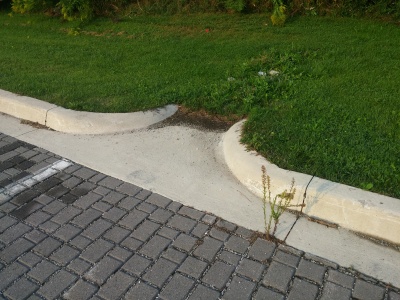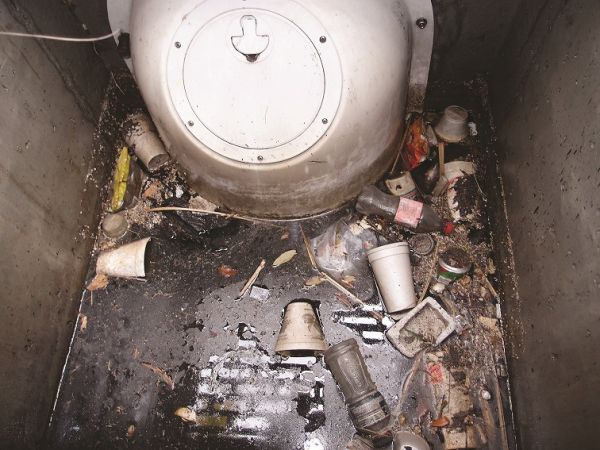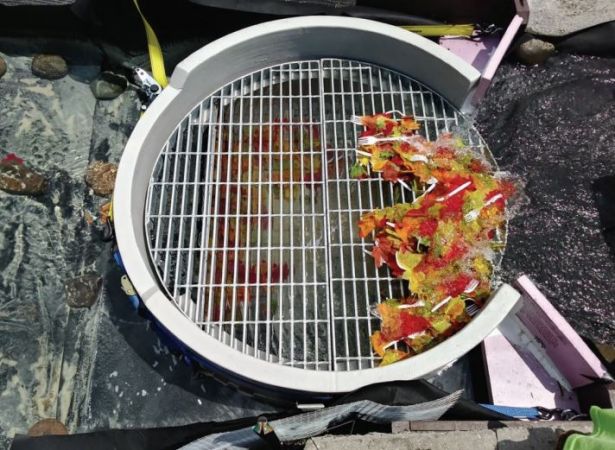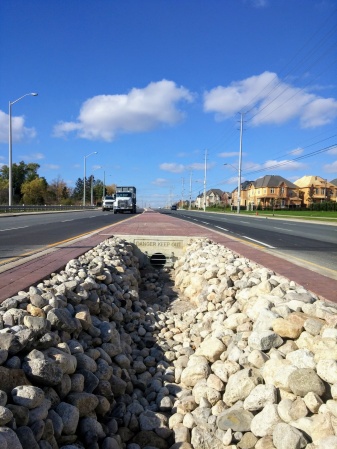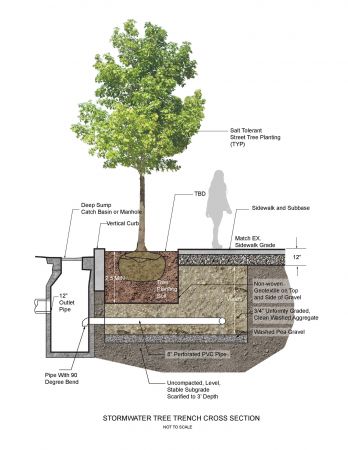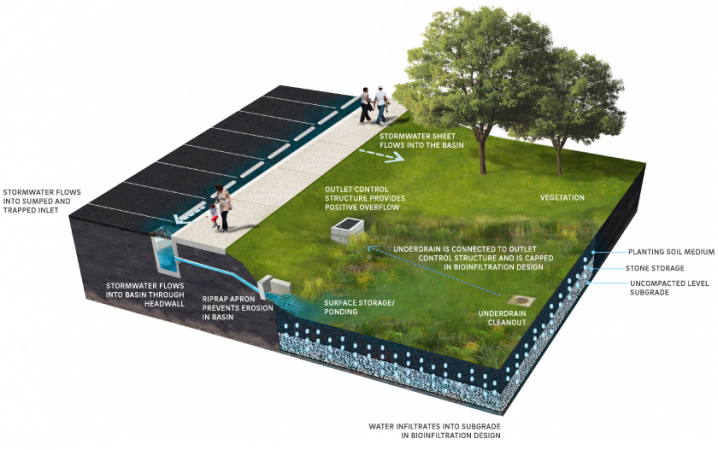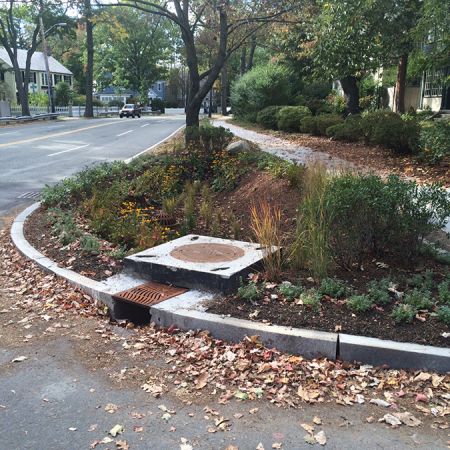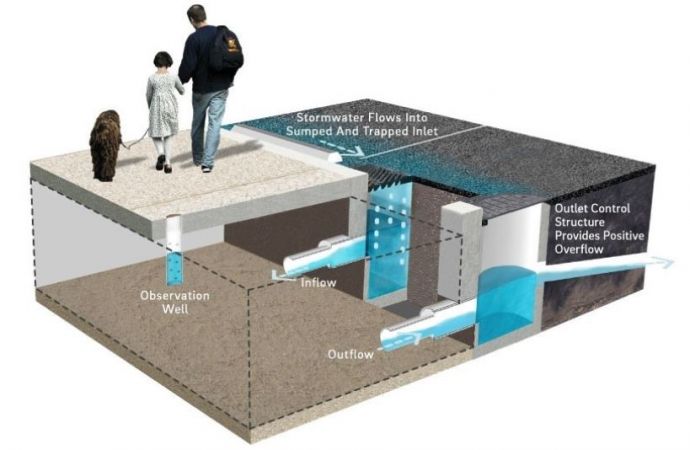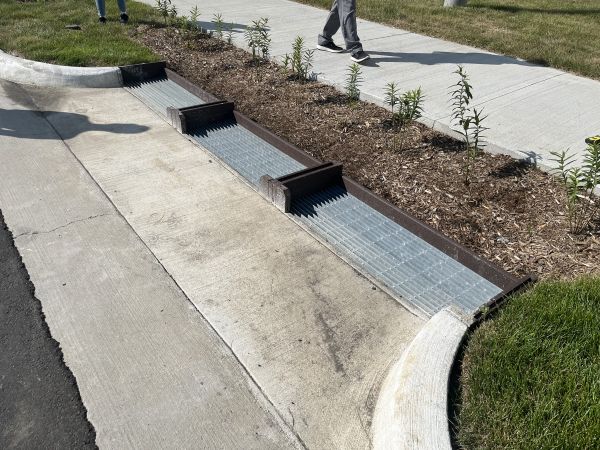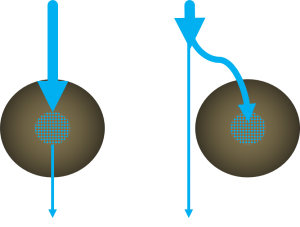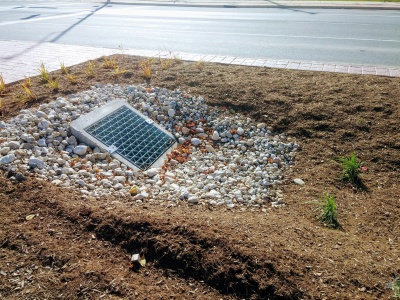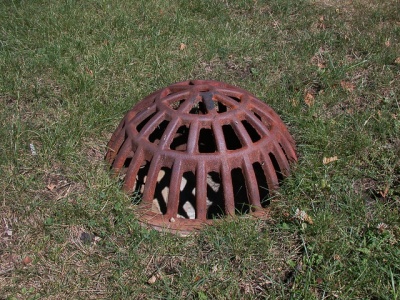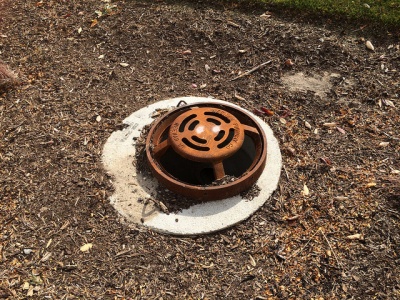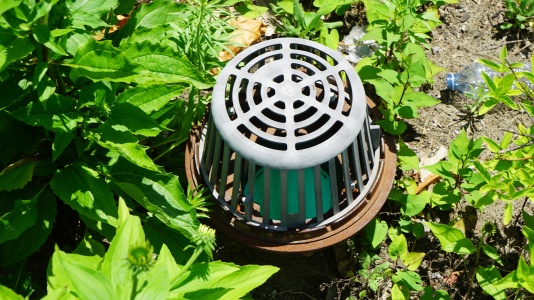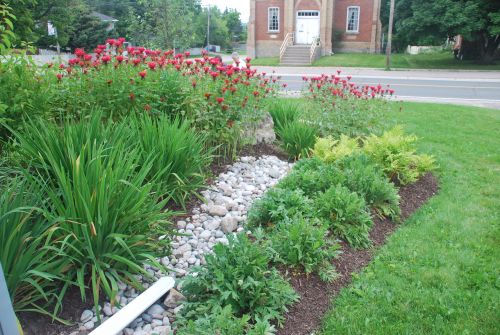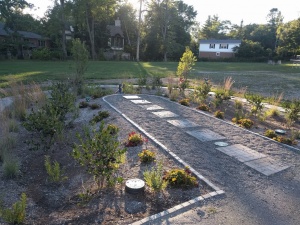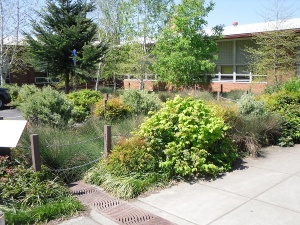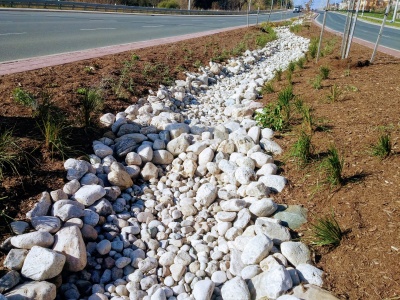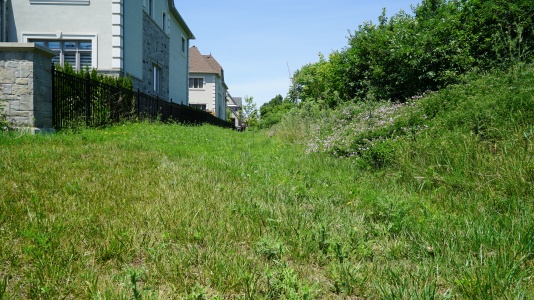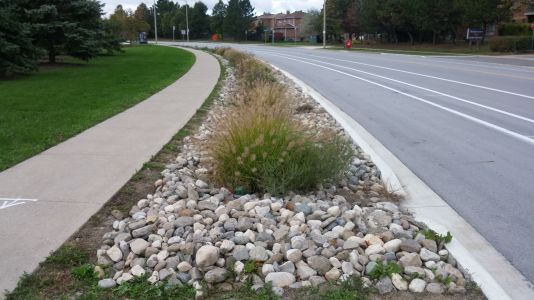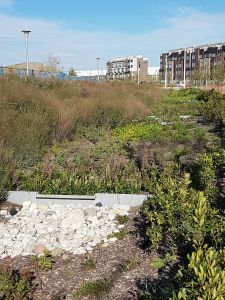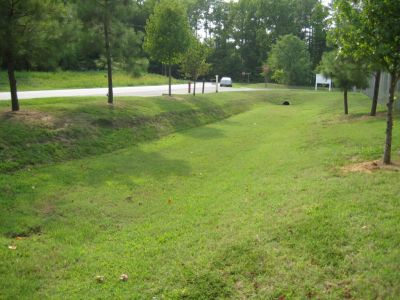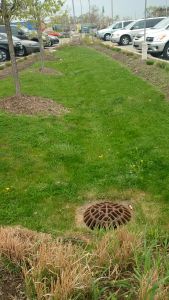Bioswales
This article is about installations designed to capture and convey surface runoff along a vegetated channel, whilst also promoting infiltration.
For underground conveyance which promotes infiltration, see Exfiltration trenches.
For design recommendations on grassed channels, see Enhanced swales.
Overview[edit]
The fundamental components of a bioswale are:
- A graded channel
- Planting
- Underdrain with clean out and inspection ports
- Filter media, to permit infiltration into the facility (not necessarily to soils below)
Additional components may include:
- Impermeable membrane to prevent infiltration to soils below
- Check dams to facilitate short tern ponding
Planning considerations[edit]
Design[edit]
Bioswales are sized as narrow linear bioretention cells. Drainage time of bioswales are typically lower than other geometric configurations of similarly sized bioretention facilities, owing to the higher hydraulic radius of the sides.
Inlets[edit]
Overview[edit]
Concentrated flow inlets are associated with LID practices such as Bioretention, Stormwater planters, Infiltration trenches and chambers. Sheet flow alternatives include level spreaders, gravel diaphragms and vegetated filter strips. Practices such as permeable pavements and green roofs receive precipitation directly, whilst exfiltration trenches are connected directly to conventional storm sewers.
Inlets for BMPs in the right of way should be located:
- At all sag points in the gutter grade
- Immediately upgrade of median breaks, crosswalks, and street intersections.
It is recommended to include multiple inlets, sized to distribute inflow along the length of the practice or between multiple facilities, where feasible, rather than concentrating all inflow into a single location. (Offline overflow).
Trench drains[edit]
Trench drains are long, covered channels that collect and direct water into the BMP. They are an excellent solution for streets where walking across the entire surface is to be encouraged. They can be designed as detectable edges or part of a detectable edge, and may be used to help define curbless or 'complete streets'.
Trenches may either be shallow (where runoff volume is less of an issue) or deep and covered by a metal grate. Deeper trench drains may gather sediment and require frequent maintenance.
Drains may be configured either perpendicular or parallel to the flow direction of the roadway, collecting runoff and directing to a single inlet in the BMP.
Combination of trench drain and winter shut off gate: King Street, Kitchener, ON
Trench drain that outlets to a bioswale at the LSRCA Office in Newmarket, ON
Bioretention system, or rain garden with a decorative trench drain cover, in Portland, US Taken in April 2013. Photo credit:EmilyBlueGreen
Curb cuts[edit]
Curb cuts are breaks along the length of a curb system to allow water to flow into a LID/BMP.
Inlet aprons or depressions increase inflow effectiveness of curb cuts. Steeply angled aprons can be hazardous, especially to people bicycling. Curbside and protected bike lanes along concrete aprons should be at least 1.8 m to give cyclists adequate clear width from the curb and any pavement seams. Aprons can also be marked visually to indicate their perimeter. For aprons into bioretention, the curb may angle into the cell to improve conveyance of gutter flow into the facility. Aprons typically drop 50 mm into the bioretention cell, with another 50 mm drop behind the curb to maintain inflow as debris collects. A depressed concrete apron can be cast in place or retrofitted in by grinding down the existing concrete pavement.
Where the curb alignment along the street is straight, the curb opening may optionally have a bar across the top of the inlet.
See Curb cuts for further details and references to Ontario Provincial Standard Drawings.
This curb cut has been sawn into existing concrete as part of a retrofit. Note the temporary (erosion log) and permanent stone erosion control measures in place. Mississauga Road, ON.
Curb cut used as a controlled overflow route from permeable pavement to a bioretention facility with monitoring well, Lake Simcoe Region Conservation Authority, Newmarket, ON.
Curb cut into a bioretention facility in Brown Deer, WI. Stone is used to reduce erosion around the inlet area. Photo credit: Aaron Volkening
Stone lined inlet at IMAX site in Mississauga
The grading around this inlet prevents flow in the correct direction. i.e. from the pavement onto the grass. Not too critical in this example, as the surface is permeable pavement.
Inlet sumps[edit]
An inlet sump is recommended to settle and separate sediments from runoff where a large amount of debris is expected. Water drains into a catch basin, where debris settles in its sump. After pretreatment, water drains via a pipe or opening into the BMP. The sump can be directly connected to a perforated underdrain pipe to distribute the flow to the bioretention, supported soil cells or underground practices such as trenches or chambers.
Sump inlets should not be sited where pedestrians will have to negotiate with them.
This pretreatment device, known as a baffle helps to remove trash, oil, TSS, larger sediments (silts, sands, etc.) and other floatables in roadway catch basins. This picture was taken of a SNOUT BAFL in Myrtle Beach, S.C. (Mullen, 2022)[1]
Example of an overland flow sump, capturing stormwater runoff from the adjacent roadway. This example showcases a Rain Guardian(TM) Turret structure with a metal grate overtop to capture larger floatables, trash and detritus from entering a stormwater facility or in this case a bioretention LID feature[2].
A stormwater tree trench, including a sump inlet design used as part of pretreatment. The feature is located in the City of Cambridge, Massachusetts, US. The design was developed and lead by HDR Inc., and Halvorson, Tighe & Bond Studio (Halvorson, Tighe & Bond Studio, n.d.)[3]
Example of a sump inlet being used in conjunction with a large bioretention basin feature, located in park space receiving stormwater off of the adjacent roadway (Source: Philadelphia Water Department, n.d.)[4]
An inlet sump leading into a bioretention bump out for traffic calming. Inlet sumps help both settle and separate sediment from stormwater road runoff before depositing excess sediment and silt into an infiltration BMP. These sumps allow stormwater to flow into the feature through an underdrain pipe (Source: NACTO, 2017)[5]
Example of a sump inlet allowing sediment to settle out of influent stormwater before entering a large infiltration chamber housed under the parking lot (Source: Philadelphia Water Department. 2020)[6]
Example of a proprietary inlet device known as a Rain Guardian Bunker, that was installed at the Morningside Extension Project in Scarborough, ON.
Depressed drains[edit]
Runoff in the gutter drops into a grate-covered drain before flowing into the BMP. Drain covers must be compatible with bicycling and walking; grid covers are preferred. Depressed drains are a potential solution for bioretention cells on sloped streets where directing runoff into the cell is a challenge.
This style of inlet can be combined with a curb cut, to maintain capacity in case debris clogs the grate.
External links[edit]
Overflow[edit]
Routing[edit]
- Infiltration facilities can be designed to be inline or offline from the drainage system. See figure to the right for an illustration.
- Inline facilities accept all of the flow from a drainage area and convey larger event flows through an overflow outlet. The overflow must be sized to safely convey larger storm events out of the facility. The overflow must be situated at the maximum surface ponding elevation or furthest downgradient end of the facility to limit surface ponding during periods of flow in excess of the facility storage capacity.
- Offline facilities use flow splitters or bypass channels that only allow the design storm runoff storage volume to enter the facility. Higher flows are conveyed to a downstream storm sewer or other BMP by a flow splitting manhole weir or pipe, or when the maximum surface ponding depth has been reached, by by-passing the curb opening and flowing into a downstream catchbasin connected to a storm sewer.
Overflow Elevation[edit]
The invert of the overflow should be placed at the maximum water surface elevation of the practice (i.e. the maximum surface ponding level). A good starting point is 150 to 350 mm above the surface of the mulch cover. However, consideration should be given to public safety, whether or not an underdrain is included, the time required for ponded water to drain through the filter bed surface, and if no underdrain is present, into the underlying native soil (must drain within 48 hours). See Bioretention: Sizing and Stormwater planters for more details.
Freeboard[edit]
- In swales conveying flowing water a freeboard of 300 mm is generally accepted as a good starting point.
- In bioretention the freeboard is the difference between the invert elevation of the inlet and overflow structure. 150 mm will usually suffice, so long as the inlet will not become inundated during design storm conditions.
- In above grade stormwater planters, the equivalent dimension would be the difference between the invert elevation of the lip of the planter and the overflow structure (150 mm minimum).
Overflow Outlet Options[edit]
Metal grates are recommended (over plastic) in all situations.
| Feature | Anti Vandalism/Robust | Lower Cost Option | Self cleaning |
|---|---|---|---|
| Dome grate | x | ||
| Flat grate | x | ||
| Catch basin | x | ||
| Ditch inlet catch basin | x | x | |
| Curb cut | x | x | x |
Gallery[edit]
Flat metal overflow with stone surround to reduce erosion around the cast concrete structure. Mississauga Road, ON
Domed, metal overflow grate. Being flush with the surface reduces potential infiltration of ponded water. Photo credit: Aaron Volkening
Overflow inlet for newly constructed stormwater bioretention areas in median of Bradley Road. Village of Brown Deer, Wisconsin. Bradley Road, east of 51st Street. Photo from October 2015. Constructed summer 2015.
Photo credit: Aaron Volkening
Materials[edit]
Whatever the choice of style, it is essential that the surrounding context is taken into account. While a planting design can have a natural appearance, the landscape should never appear haphazard or messy. The aesthetic goal is to achieve a visual sense of fit and scale with the site. The design should be intentional, appropriate and pleasing to the eye and consider the following:
- Maintain visual interest throughout the seasons
- Use of selective species palate
- Use of one or two species or elements to create an accent
- Consistency in plant placement and spacing; incorporating mass groupings, repeating plant groupings, materials and/or design elements
- Avoid sparsely spaced greenery; the planting beds should be fully vegetated once mature
- Consider habitat attributes of plant material
- Enhanced LID function related to pollutant uptake, temperature mitigation, filtration, and evapotranspiration
To help you select appropriate plants for your site, we've developed tables for graminoids, perennials, shrubs, climbing plants, trees and turf focusing on their suitability for implementing LID practices and their aesthetic appeal.
Basic principles[edit]
The basic principles of landscape design that should be considered in the creation of any planting plan, no matter how small, are described below. For projects that don't require a landscape architect, LID proponents may have to engage in small-scale landscape design. Not all of the following principles need to be applied in each case, but a basic understanding of each provides guidance. The manner in which these principles are applied creates a particular aesthetic.
Unity and Simplicity[edit]
Unity and simplicity in planting design is essential to create an appealing aesthetic. This can be achieved through repetition and consistency. The landscape associated with an LID practice needs to convey that all parts of the planting design fit together to make a whole. The repetition of groups of plants or the character of elements (ie. height, size, texture, and colour) throughout the landscape design can assist on creating a sense of unity in the landscape.
Whilst repetition is a key element used to achieve unity, it is important not to overuse this technique as the result can become monotonous. A landscape design that employs a variety of species in groupings that are repeated throughout a site assists in achieving unity and interest. In contrast, a design that uses just two or three species repeated throughout the entire LID practice may be monotonous.
There is often one visually dominating item or component in a landscape design. Every other component in the design should then be subordinate to this single, dominating focal point. Properly selecting and setting this one focal point in a view should evoke a feeling of satisfaction and pleasure. [7]
Variety and Rhythm[edit]
The subtle varying of contrast in line, form, texture or colour can attract attention to a design without inhibiting the overall unified appearance of the design, particularly if there is a smooth, gradual and progressive change in the design element. If applied sparingly, the result can be an increased attraction to the overall composition. [8]Moreover, the creation of sequence may be achieved by using gradation (e.g. the progressive changing of sizes of components or intensity of textures) or by using fixed repetition (i.e. the repeating of an element on a constant spacing) or by using alteration (i.e. the alternating of contrasting or graded colours and textures). When done successfully, the designer creates a sense of movement or flow through a design. [7]
Grouping/massing[edit]
Planting different species as single individuals can create a disjointed and un-natural aesthetic in a landscape design. Plants should be placed into groupings of varied numbers (e.g. groups of 3, 5 or 7) to create a mass, which can create a much greater visual appeal. One way to create a grouping is by beginning with a larger specimen, and then adding smaller species with complementary textures, colours and shapes. To create a seasonal grouping, evergreen species, and species with dormant season distinctiveness (ie. form, height, colour) should be included.
Balance[edit]
Balance must generally equalize the overall impact of each of the different design elements so that a visually harmonious composition results. [7] Balance in a landscape design can be either symmetrical or asymmetrical. A symmetrical design is one that exactly duplicates itself along an axis. The informal nature of many LID practices tends to promote the application of the asymmetrical balance approach. This is achieved through the irregular placement of plant groupings along an imaginary axis so that the resulting mass is balanced.
Scale/proportion[edit]
Scale and proportion simply refer to the size of the elements, objects and spaces of the landscape in relation to one another, to the LID site and to its surroundings. While there are no rules dictating how this principle is to be achieved, it is important to consider scale and proportion when designing. The relationship in size between components must b relative, or the result can be a lack of harmony in the design.[9] For example, the placement of a large tree in a stormwater planter would be out of scale for this site condition, while the planting of an individual ornamental flower species may appear insignificant in a bioretention cell. Some plant materials may require management (thinning, pruning) in order to maintain the scale and proportion of the intended design over time.
Colour[edit]
Colour animates a landscape design. It is affected by light at different times of the day and changes throughout the seasons. Flowers, fruit, leaves or bark of vegetation contribute to colour variation; in response, the designer should understand the details of the life cycle of the plants to be utilized and include plants that flower at different times of year. Colour theory dictates that warm colours (red, orange, yellow) take prominence in the view, while cool colours (green, blue, violet) recede. Colour also has an emotional impact:
- red = strong
- green = tranquil
- blue = dignified
- violet = sophisticated
- brown = earthy
- gray = somber
- black = serious
- orange = exuberant
- yellow = positive
- white = pure [10]
Colour can be used in developing unity, repetition and balance in a landscape design, and to direct the eye to a focal point, if desired.
Texture[edit]
The designer should be aware of the texture of the planting materials specified. An appealing aesthetic can be achieved by contrasting fine textured vegetation, such as grasses, sedges, with coarser texture species. However, in exploring design solutions it is important to understand the distance from which the LID practices will be viewed, and to mass vegetation textures accordingly when applying this element to the design. Using both coniferous and deciduous vegetation helps create visual appeal throughout the seasons.
Line[edit]
Straight lines represent clean, more formal organizing elements in a design, and they imply a sense of direction and movement. Curved, organic lines promote a more ‘natural’ aesthetic. In either case, clean and contrived shapes have a greater visual interest than weak shapes or indistinct edges.
Form[edit]
Form describes natural shape of an individual plant. The variety of forms include weeping, globular, spreading or columnar. The form of plants should be considered both individually and as they relate in the composition of the design.
Features[edit]
Features incorporated into planting designs, such as benches, stones, paths, and works of art, can make LID spaces more aesthetic, enjoyable and multi-functional.
Planting plans and specifications[edit]
A qualified landscape architect should prepare documents in coordination with engineering design, including tender documents that encompass site development, soil preparation and earthworks. Plans are prepared on a site-specific basis, incorporating planting layout, species composition and spacing. In addition, landscape plans should include construction details and pertinent notes specifying site supervision, monitoring and maintenance.
Early initiatives and successes are more likely to be public, commercial or industrial applications as there is a higher requirement for landscape professionals to be involved and usually a greater opportunity to control and monitor initiatives. Contracts for LID practices may need to be structured slightly differently than a standard construction contract in order to address the long term function of the LID practice, including provision for an extended warranty period.
- Vegetation must meet Canadian Standards for Nursery Stock, 9th Ed[11].
- Seed planting is not recommended for low impact development.
- Plants should be container grown, balled and burlapped or wire basket.
| Deciduous Trees | 45 mm calliper |
| Coniferous Trees | 175 cm height |
| Deciduous Shrubs | 60 - 80 cm height |
| Coniferous Shrubs / Broadleaf Evergreens |
|
| Perennials and grasses | #1 or 1 gal. container stock |
| Vines | #1 or 1 gal. container and staked |
Plant Installation[edit]
Planting with plugs, pots, caliper tree or shrub stock or sod is preferable over broadcast seeding approaches. Seeding requires stormwater practices to be kept off-line for a period of time following planting to allow germination and plant establishment to occur, and to be irrigated in the absence of adequate rainfall to ensure success.
Plants should be kept in their containers until they are to be installed, which should take place as soon as possible upon completion of the grading and installation of drainage structures. In addition to the planting plan, plant installation details for herbaceous plants, shrubs and trees should be followed per municipal and landscape industry standards, specifications, and guidelines. Avoid staking unless necessary (ie. vandalism or high wind exposure). If staked, then the ties should be a biodegradable web or burlap and removed after the first growing season. If any plant substitutions are required, then the contractor or contract administrator should defer to the designer or municipal agency to make the substitution.
If broadcast seeding is the chosen planting approach, the practice should be disconnected from the drainage area for the duration of the plant establishment period (e.g., first growing season) and seeded areas should be protected with biodegradable erosion control matting to protect seeds from erosion by wind and water.
See Also[edit]
- Plant lists
- Bioretention
- Bioswales
- Enhanced grass swales
- Green roofs
- Rain gardens
- Stormwater planters
- Stormwater tree trenches
- Swales
- Vegetated filter strips
- Wetlands
Gallery[edit]
Streetside swale in Seattle
This feature is a bioswale in that the underlying soil has been replaced with engineered filter media. The turf finish simplifies landscape maintenance. Brampton, ON
A bioswale located on Country Court Blvd., located in Brampton, ON> Read more about the performance of this feature and associated rpoject, by reading the following Grey to Green Conference Presentation, 2018. Dean Young - STEP, 2018
Bioswale located in Downsview Park, Toronto ON. with Check dams.
Grassed bioswale with Vegetated filter strips
Stone-lined bioswale with rock check dams located to helps slow the flow of water as it enter the system from the nearby roads. [[ STEP, 2017
Performance[edit]
While few field studies of the pollutant removal capacity of bioswales are available from cold climate regions like Ontario, it can be assumed that they would perform similar to bioretention cells. Bioretention provides effective removal for many pollutants as a result of sedimentation, filtering, plant uptake, soil adsorption, and microbial processes. It is important to note that there is a relationship between the water balance and water quality functions. If a bioswale infiltrates and evaporates 100% of the flow from a site, then there is essentially no pollution leaving the site in surface runoff. Furthermore, treatment of infiltrated runoff will continue to occur as it moves through the native soils.
| LID Practice | Location | Runoff Reduction* | Reference |
|---|---|---|---|
| Bioswale without underdrain | Washington | 98% | Horner et al. (2003)[12] |
| Scotland | 94% | Jefferies (2005)[13] | |
| Bioswale with Underdrain | Maryland | 46 to 54% | Stagge (2006)[14] |
| Bioretention without underdrain | China | 85 to 100%* | Gao, et al. (2018)[15] |
| Connecticut | 99% | Dietz and Clausen (2005) [16] | |
| Pennsylvania | 80% | Ermilio (2005)[17] | |
| Pennsylvania | 70% | Emerson and Traver (2004)[18] | |
| Bioretention with underdrain | |||
| Ontario | 64% | CVC (2020)[19] | |
| Maryland and North Carolina | 20 to 50% | Li et al. (2009) [20] | |
| North Carolina | 40 to 60% | Smith and Hunt (2007)[21] | |
| North Carolina | 33 to 50% | Hunt and Lord (2006) [22] | |
| Runoff Reduction Estimate* | 85% without underdrain;
45% with underdrain | ||
- ↑ Mullen, T.J. Prioritizing trash capture and clean oceans: Stormwater hoods and traps lead the way in effectiveness. The Municipal magazine. June 1, 2022. Accessed: https://www.themunicipal.com/2022/06/prioritizing-trash-capture-and-clean-oceans-stormwater-hoods-and-traps-lead-the-way-in-effectiveness/
- ↑ Erickson, A.J. and Hernick, M.A., 2019. Capture of Gross Solids and Sediment by Pretreatment Practices for Bioretention. Accessed: https://conservancy.umn.edu/handle/11299/201607
- ↑ Halvorson, Tighe & Bond Studio. n.d. Halvorson, Tighe & Bond Studio. Retrieved from: https://www.halvorsondesign.com/willard-street-drainage
- ↑ Philadelphia Water Department. n.d. Chapter 4 Stormwater Management Practice Guidance 4.1 Bioinfiltration/Bioretention. Retrieved from: https://water.phila.gov/development/stormwater-plan-review/manual/chapter-4/4-1-bioinfiltration-bioretention/
- ↑ National Association of City Transportation Officials (NACTO). 2017. Urban Street Stormwater Guide - Inlet Design. Retrieved from: https://nacto.org/publication/urban-street-stormwater-guide/stormwater-elements/bioretention-design-considerations/inlet-design/
- ↑ Philadelphia Water Department. 2020. Stormwater Management Guidance Manual: Version 3.2. Accessed from: https://www.pwdplanreview.org/upload/manual_pdfs/PWD-SMGM-v3.2-20201001.pdf
- ↑ 7.0 7.1 7.2 Landscape Design Manual, Landscape Ontario (2014) Page 52
- ↑ Landscape Design Manual, Landscape Ontario (2014) Page 51
- ↑ Landscape Design Manual, Landscape Ontario (2014) Page 53
- ↑ Landscape Design Manual, Landscape Ontario (2014) Page 55-55
- ↑ https://cnla.ca/uploads/pdf/Canadian-Nursery-Stock-Standard-9th-ed-web.pdf
- ↑ Horner RR, Lim H, Burges SJ. HYDROLOGIC MONITORING OF THE SEATTLE ULTRA-URBAN STORMWATER MANAGEMENT PROJECTS: SUMMARY OF THE 2000-2003 WATER YEARS. Seattle; 2004. http://citeseerx.ist.psu.edu/viewdoc/download?doi=10.1.1.365.8665&rep=rep1&type=pdf. Accessed August 11, 2017.
- ↑ Jefferies, C. 2004. Sustainable drainage systems in Scotland: the monitoring programme. Scottish Universities SUDS Monitoring Project. Dundee, Scotland. https://www.climatescan.nl/uploads/projects/8126/files/1277/SNIFFERSR_02_51MainReport.pdf
- ↑ Stagge, J. 2006. Field evaluation of hydrologic and water quality benefits of grass swales for managing highway runoff. Master of Science Thesis, Department of Civil and Environmental Engineering, University of Maryland. https://drum.lib.umd.edu/items/42be6ce6-e4ef-4162-a991-c273607d422d
- ↑ Gao, J., Pan, J., Hu, N. and Xie, C., 2018. Hydrologic performance of bioretention in an expressway service area. Water Science and Technology, 77(7), pp.1829-1837.
- ↑ Dietz, M.E. and J.C. Clausen. 2005. A field evaluation of rain garden flow and pollutant treatment. Water Air and Soil Pollution. Vol. 167. No. 2. pp. 201-208. http://citeseerx.ist.psu.edu/viewdoc/download?doi=10.1.1.365.9417&rep=rep1&type=pdf
- ↑ Ermilio, J.F., 2005. Characterization study of a bio-infiltration stormwater BMP (Doctoral dissertation, Villanova University). https://www1.villanova.edu/content/dam/villanova/engineering/vcase/vusp/Ermilio-Thesis06.pdf
- ↑ Emerson, C., Traver, R. 2004. The Villanova Bio-infiltration Traffic Island: Project Overview. Proceedings of 2004 World Water and Environmental Resources Congress (EWRI/ASCE). Salt Lake City, Utah, June 22 – July 1, 2004. https://ascelibrary.org/doi/book/10.1061/9780784407370
- ↑ Credit Valley Conservation. 2020. IMAX Low Impact Development Feature Performance Assessment. https://sustainabletechnologies.ca/app/uploads/2022/03/rpt_IMAXreport_f_20220222.pdf
- ↑ Li, H., Sharkey, L.J., Hunt, W.F., and Davis, A.P. 2009. Mitigation of Impervious Surface Hydrology Using Bioretention in North Carolina and Maryland. Journal of Hydrologic Engineering. Vol. 14. No. 4. pp. 407-415.
- ↑ Smith, R and W. Hunt. 2007. Pollutant removals in bioretention cells with grass cover. Proceedings 2nd National Low Impact Development Conference. Wilmington, NC. March 13-15, 2007.
- ↑ Hunt, W.F. and Lord, W.G. 2006. Bioretention Performance, Design, Construction, and Maintenance. North Carolina Cooperative Extension Service Bulletin. Urban Waterways Series. AG-588-5. North Carolina State University. Raleigh, NC.
